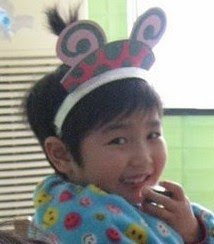After the whirlwind of the first three days here in Nanjing, the last two days have provided a welcome respite. While some of the other families traveled to their children’s orphanages, we’ve caught up a bit on our rest and have been able to fully focus on bonding with Lily.
This blog is mostly for those families we’ve gotten to know by email who are still waiting to pick up their children.
With amazement, we are watching Lily develop before our eyes. Before traveling to China, we had read about how some adopted children experience a developmental spurt. But we had no idea how dramatic it can be.
Although she is almost 14 months old, Lily is much like an infant. When we picked her up she was unable to sit up on her own, unable to roll over, and unable to put food in her mouth (so much for Cheerios!). She would not eat any solid food, and was still timid about eating soft foods from a spoon. Much of her waking time was spent just watching activities going on around her. She could pick objects up, but did little more than just stare at them.
Her speech was limited to a couple of words her nannies had taught her in preparation for our arrival—“Ma Ma” and Da Da” (although those are really great to hear!). Other sounds were very much like the cooing sounds of infants. She was able to make a popping or smacking sound with her lips, which she learned from one of her nannies that we met at the orphanage. Her facial expression was mostly blank, with an occasional smile.
Most uncomfortable for us was Lily’s dislike of being held close, or being touched or stroked. Areas she most disliked being touched were her head, face, and hands. Her most comfortable position was being held flat on her back. When we’d attempt to hold her against our shoulders she would jerk backwards. Snuggling was not her thing.
Now fast forward to today, 4 days since we picked Lily up. The results of the stimulation and encouragement we’ve been able to give to her have resulted in some of the following developmental behaviors:
Working at trying to sit up and roll over (she’s almost got it!)
Snuggling against our shoulders and being held in a cradle position
Actively playing with simple toys like stacking cups; even tossing them away
Letting us physically play with her, including “rough housing”, peek-a-boo, kissing her head, etc.
Holding a cookie and nibbling on it
Eating comfortably from a spoon
Imitating our behaviors, such as sticking out her tongue, opening her mouth wide, and playing patty-cake
Handing things to us and then taking them back
Smiling and cooing when either of us comes into view and then reaching out to be picked up
Giggling with delight
Our message to waiting parents is to be prepared for most anything. You can’t plan for how your child will react to this huge change in their life. Each set of parents in our group has experienced something totally different. Each child is acting out in their own way and experiencing grief in their own way. Behaviors that start either positively or negatively can abruptly go the other way; and then back again.
When we visited the orphanage we only got a snapshot view of daily life in the babies section, but here are a few things we observed that we feel help us better understand what we are observing in these children.
The cribs are much of the child’s world. They are very small. Side bumpers limit the view of the world to what is above; the child cannot see his/her crib neighbor. The ceiling and walls are plain with no pictures or paintings. There are no crib mobiles. There are few toys; a few stuffed animals. The children were all on their backs, watching the world above them or exhibiting some sort of repetitive behavior. When John reached to hold each child’s hand and say hello, there was generally no reaction.
The play room consisted of children sitting or rolling about in wheeled walkers. There were no other toys in view. There was one playpen containing no toys.
The rooms, the cribs, and the linens were very clean. The bathroom we saw had a tub and was very clean. The nannies were dressed in clean crisp white uniforms and were very friendly. They were sincerely happy to see Lily again and grabbed her up as soon as Pamela would hand her to them. They were mostly young women, in their twenties and thirties.
We highly recommend a visit to your child’s orphanage if it is allowed and can be arranged. (We were surprised to learn that our orphanage only has 7-8 sets of parents visit each year.) We feel our added understanding of Lily’s first year has already been, and will continue to be, a critical piece in our helping guide her through the coming months and years.
Thanks for checking in.































































